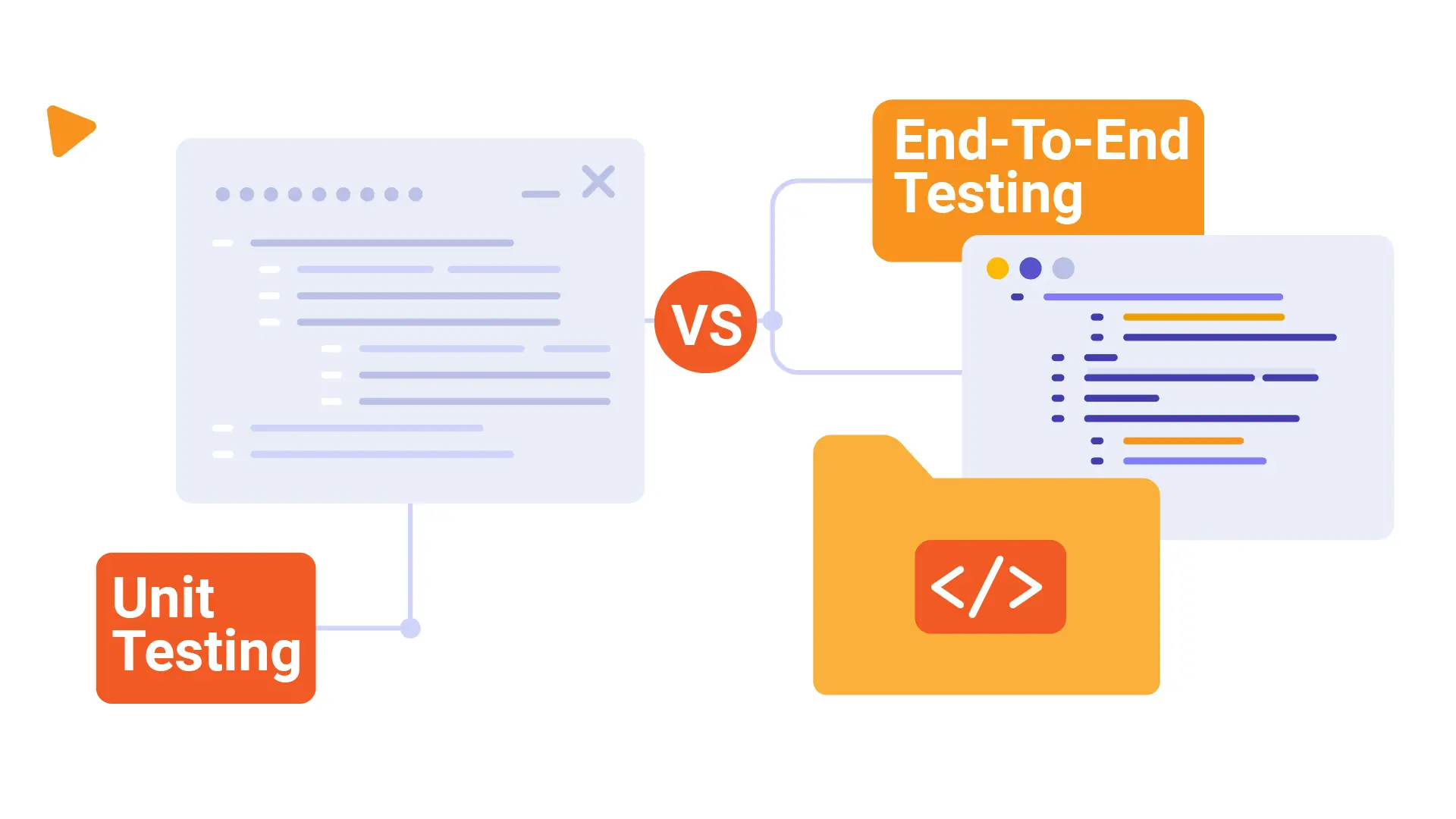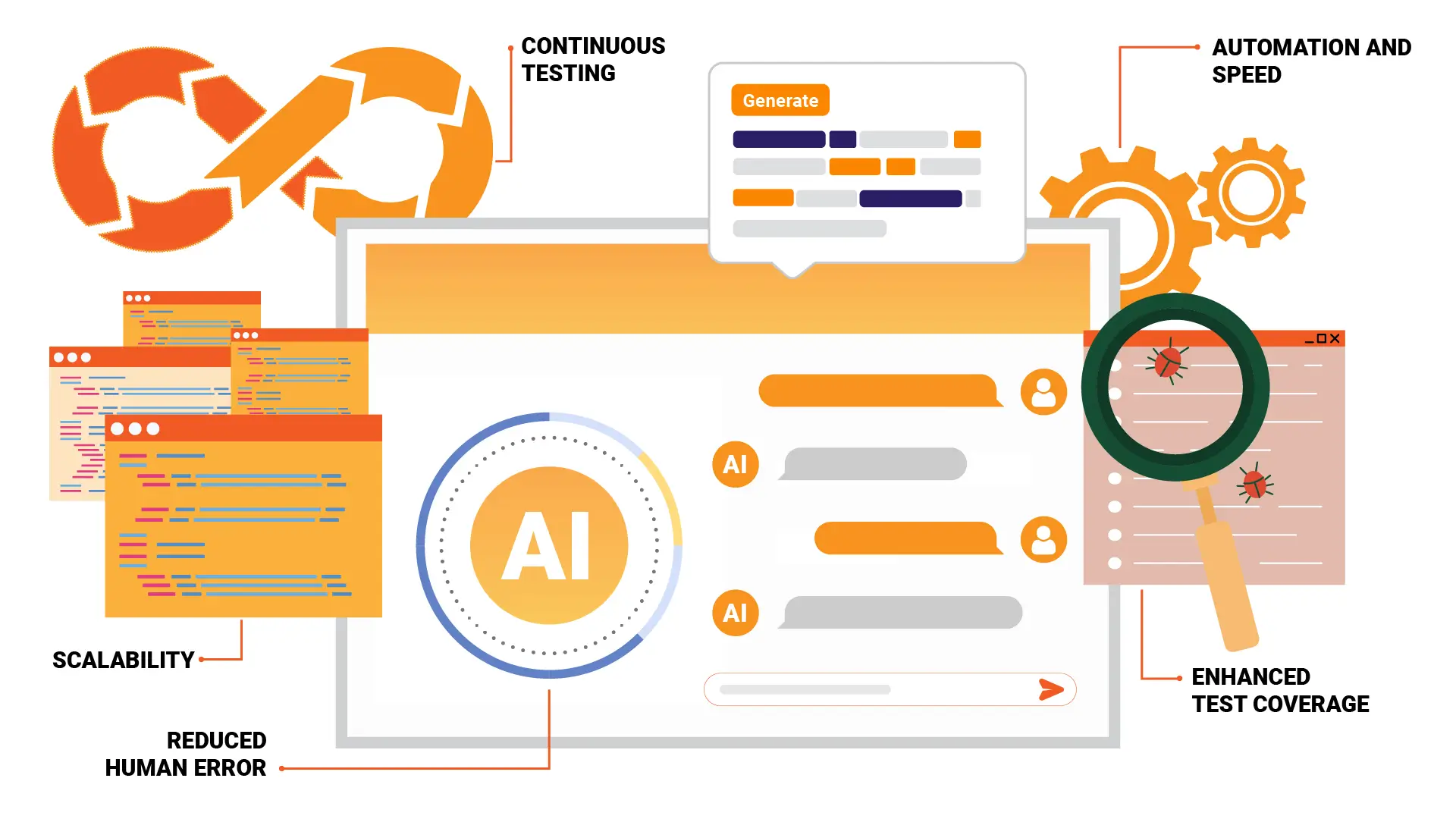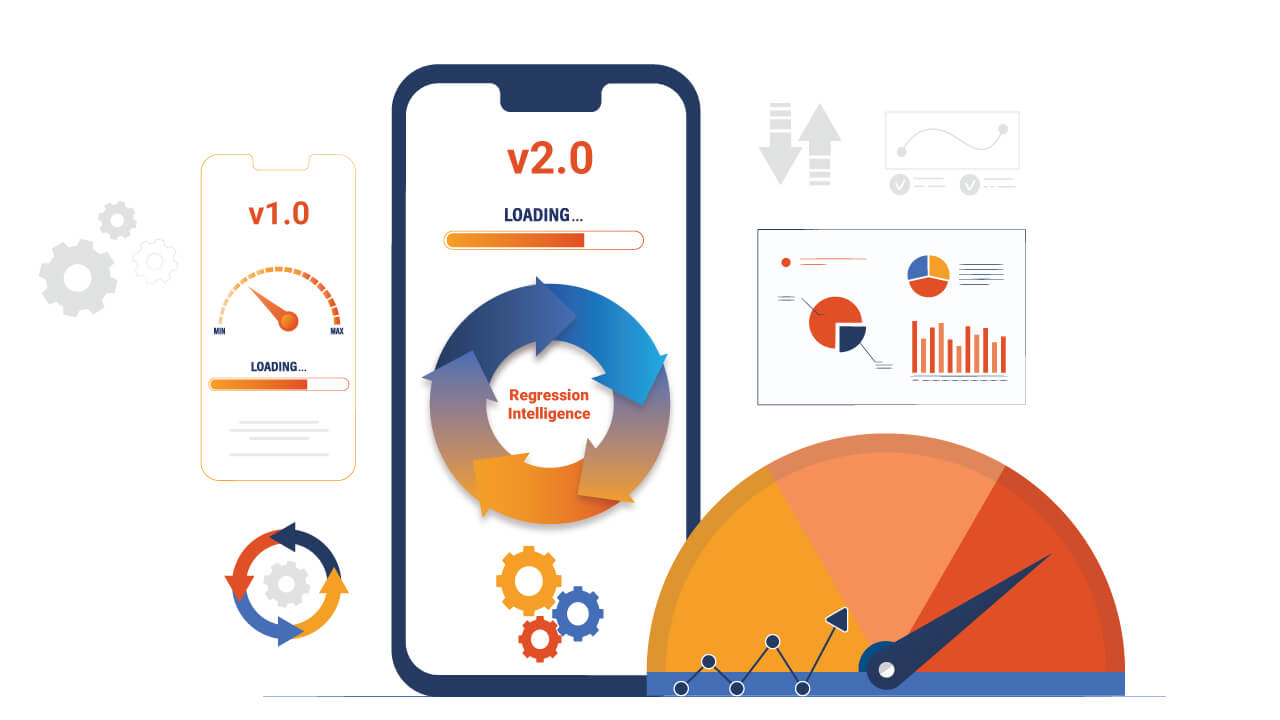In the complex landscape of software development, ensuring the reliability and functionality of applications is paramount. Two fundamental approaches to achieving this are unit testing and end-to-end testing. Each strategy serves a unique purpose, and together, they form the backbone of a robust software testing regime.
What is Unit Testing?
Unit testing helps test individual code components in isolation from the rest of the app. Depending on the programming language used, these units can be functions, methods, or classes. The essence of unit testing is to ensure that each piece of the code performs as expected under various conditions.
This method needs developers to deeply understand the code's functionality, as tests are designed to cover all possible input scenarios, including edge cases, to guarantee that the code behaves correctly.
One of the key advantages of unit testing is its ability to be automated, allowing tests to be run quickly and frequently. This automation supports a practice known as test-driven development (TDD), guiding the development process to meet the predefined specifications.
Benefits of Unit Testing
Unit testing brings several significant advantages to the software development process:
- Improved Code Quality: Developers can build more reliable and robust applications by ensuring each unit operates correctly. This leads to a reduction in bugs and issues in the later stages of development and after deployment.
- Facilitates Refactoring: With a comprehensive suite of unit tests, developers can refactor code confidently, knowing that any introduced errors will be promptly identified. This makes the codebase more adaptable and easier to maintain.
- Accelerates Development: Unit testing can speed development by catching and fixing errors early, preventing them from escalating into more significant problems. This efficiency reduces the time spent on debugging and troubleshooting.
- Documentation: Well-written unit tests can serve as documentation for the codebase, providing insights into what the code is supposed to do. This is particularly valuable for new team members or when revisiting older code.
- Enhances Design: The necessity to write testable code encourages better software design. It promotes using patterns that make the code more modular and simpler to test.
Unit testing is an essential practice that supports high-quality software development. By integrating unit testing into the development lifecycle, teams can enjoy faster development times, improved code quality, and reduced maintenance costs, ultimately leading to a more reliable and robust software product.
What is End-To-End Testing
End-to-end testing assesses an application's functionality and user experience in a complete, integrated environment that mimics real-world use. This testing approach evaluates the system's interaction with databases, networks, and other applications, ensuring that every component functions correctly within the full application flow. It's particularly useful for identifying issues related to data handling, user interface, security, and overall system performance.
The Benefits of End-To-End Testing
- Ensures Full System Validation: End-to-end testing validates not just individual components but the entire application flow, offering assurance that the system meets all business and user requirements.
- Identifies Integration Errors: Testing how different parts of the application interact helps uncover integration issues that might not be evident during unit or integration testing phases.
- Improves User Experience: Simulating real user scenarios ensures the application is user-friendly and intuitive and behaves as expected in real-world conditions, enhancing user satisfaction.
- Facilitates Early Problem Detection: By identifying issues at the system level before the product goes live, end-to-end testing can significantly reduce the cost and effort required for troubleshooting and fixing problems after deployment.
- Increases Confidence for Deployment: Completing a thorough end-to-end test cycle provides a solid foundation for confidence in the software's stability and performance, supporting a smoother launch and ongoing operations.
Incorporating comprehensive end-to-end testing into the development process is indispensable for delivering a polished, user-centric product that performs flawlessly across all intended use cases and platforms.
Read: A Comprehensive Guide to Accelerate and Strengthen Your End-to-End Testing Approach
Key Differences
- Granularity: Unit testing's focus on individual components allows developers to zero in on specific functionalities, making it easier to pinpoint errors. End-to-end testing, however, assesses the application's overall flow, capturing interactions between various components and the system, which is crucial for understanding the user's experience.
- Dependency: The isolation of unit tests means they're less prone to failures caused by external systems or network issues, leading to more stable testing outcomes. In contrast, end-to-end testing, by relying on the application's environment and external systems, can uncover issues related to network, database, and other integrations that unit tests cannot.
- Execution Time: The quick execution of unit tests supports a rapid development cycle, allowing immediate corrections. Due to their comprehensive nature and the need to simulate real user environments, end-to-end tests require more time to set up and execute, making them less frequent but critical checkpoints in the development process.
- Test Maintenance: The simplicity and close alignment of unit tests with the codebase facilitate easier updates and maintenance as the application evolves. Meanwhile, the complexity and broader scope of end-to-end tests can make them more cumbersome, especially as changes in the application's interface or functionality can necessitate significant adjustments to test scripts.
- Feedback Loop: The immediate feedback provided by unit tests is invaluable for developers, enabling quick fixes and continuous improvement. End-to-end testing offers different feedback, highlighting how well the application performs under conditions that mimic real-world use. This is essential for ensuring a positive UX.
Also read: A complete guide to user experience testing
How Software Testing Platforms Can Help
Software testing platforms offer comprehensive solutions addressing organizations' challenges during the development lifecycle, specifically in unit and end-to-end testing.
Unit Testing Challenges
- Complexity and Time Consumption: Writing and maintaining unit tests for every function or method can be time-consuming and complex, especially in large applications.
- Integration Issues: Ensuring that unit tests are properly isolated from dependencies can be challenging, leading to flaky tests.
- Coverage and Quality: Achieving high code coverage while maintaining test quality and relevance to business logic.
End-to-end Testing Challenges
- Environment and Configuration: Mimicking production environments accurately to ensure end-to-end tests are valid can be challenging due to differences in configurations and external dependencies.
- Flakiness and Reliability: End-to-end tests often suffer flakiness due to their reliance on many moving parts, making test results unreliable.
- Resource Intensive: They require significant resources to run, as they test the application from start to finish, which can be time-consuming and expensive.
Check out: 7 Differences Between Integration Testing and End to End Testing
Help Through Software Testing Platforms
Software testing platforms help address these challenges by providing:
- Automated Test Generation and Maintenance: Tools automatically generating and maintaining tests can significantly reduce the time and complexity of writing tests.
- Dependency Management: Features that allow for easy mocking or stubbing of dependencies ensure unit tests are isolated and reliable.
- Coverage Analysis: Tools that analyze code coverage help teams identify untested parts of the application, ensuring a comprehensive testing strategy.
- Scalable and Configurable Environments: Platforms offer scalable testing environments that closely mimic production settings, addressing the configuration challenge.
- Flakiness Detection and Management: Advanced algorithms can detect flaky tests and provide insights on improving their reliability.
- Resource Optimization: These platforms can reduce the resources needed for end-to-end testing by optimizing how and when tests are run.
Leveraging HeadSpin for Unit and End-to-End Testing
HeadSpin provides a robust platform that significantly enhances both unit and end-to-end testing. It integrates seamlessly with development workflows, offering automated and manual testing enriched by AI-driven insights. Here's a closer look at how HeadSpin can elevate your testing strategy:
- Device Cloud: HeadSpin's Device Cloud offers unparalleled access to a vast array of real devices across numerous locations worldwide. This extensive coverage is vital for comprehensive end-to-end testing, ensuring that applications perform optimally across different devices, operating systems, and network conditions. Organizations can uncover device-specific issues by testing on actual hardware, enhancing the user experience across all platforms and geographies.
- AI-Powered Insights: Leveraging artificial intelligence, HeadSpin analyzes test results to pinpoint problems related to performance, usability, and functionality. This automated insight helps teams focus on the most critical issues, streamlining the prioritization and fixing process. The AI-driven approach reduces the time spent on manual analysis. It improves the accuracy of identifying root causes, enabling more efficient resolution of complex problems.
- Seamless Integration: HeadSpin integrates with existing development and testing frameworks, facilitating a smoother workflow for unit and end-to-end testing. This compatibility allows teams to incorporate HeadSpin's capabilities into their current processes without significant changes, enhancing efficiency and productivity. By bridging the gap between development environments and testing platforms, HeadSpin ensures that testing is integral to the development lifecycle, from initial coding to final deployment.
- Performance Monitoring: With real-time performance monitoring, HeadSpin enables organizations to detect and address issues as they occur throughout the development cycle. This proactive approach to performance management ensures that potential issues are resolved early, preventing them from escalating into more significant concerns. Real-time monitoring covers various aspects, including load times, responsiveness, and resource usage, ensuring that applications meet the highest performance standards before release.
These features collectively make HeadSpin a powerful ally in delivering high-quality software products, enabling organizations to navigate modern app development confidently.
Complementary Strategies for Quality Assurance
Neither unit testing nor end-to-end testing should be viewed in isolation. A balanced approach, incorporating both, is crucial for delivering high-quality software. Unit testing allows early detection of issues, facilitating smoother development processes. Meanwhile, end-to-end testing is a comprehensive check before the software's final release, ensuring all parts work together perfectly in real-world scenarios.
Integrating both testing methodologies within the software development lifecycle is indispensable for creating robust, user-friendly applications that stand the test of time.
HeadSpin's platform is pivotal for developers looking to enhance the quality and reliability of their digital products. By leveraging its advanced features, teams can ensure their applications meet the highest performance and user satisfaction standards.
FAQs
Q1. Can unit testing and end-to-end testing be automated?
Ans: Yes, both unit testing and end-to-end testing can be automated. Unit testing is commonly automated as part of the development process. In contrast, end-to-end testing automation involves simulating user scenarios to ensure the entire application works as intended.
Q2. How do unit tests differ from integration tests?
Ans: Unit tests focus on individual components in isolation, whereas integration tests verify the interactions between components to ensure they work together correctly. Integration testing falls between unit testing and end-to-end testing in the testing hierarchy.
Q3. Is performing both unit and end-to-end testing necessary for every project?
Ans: While it's ideal, the extent to which both testing types are employed depends on the project's complexity, requirements, and resources. Small projects might rely more on unit testing, but larger, more complex systems benefit significantly from both approaches.



























-1280X720-Final-2.jpg)










